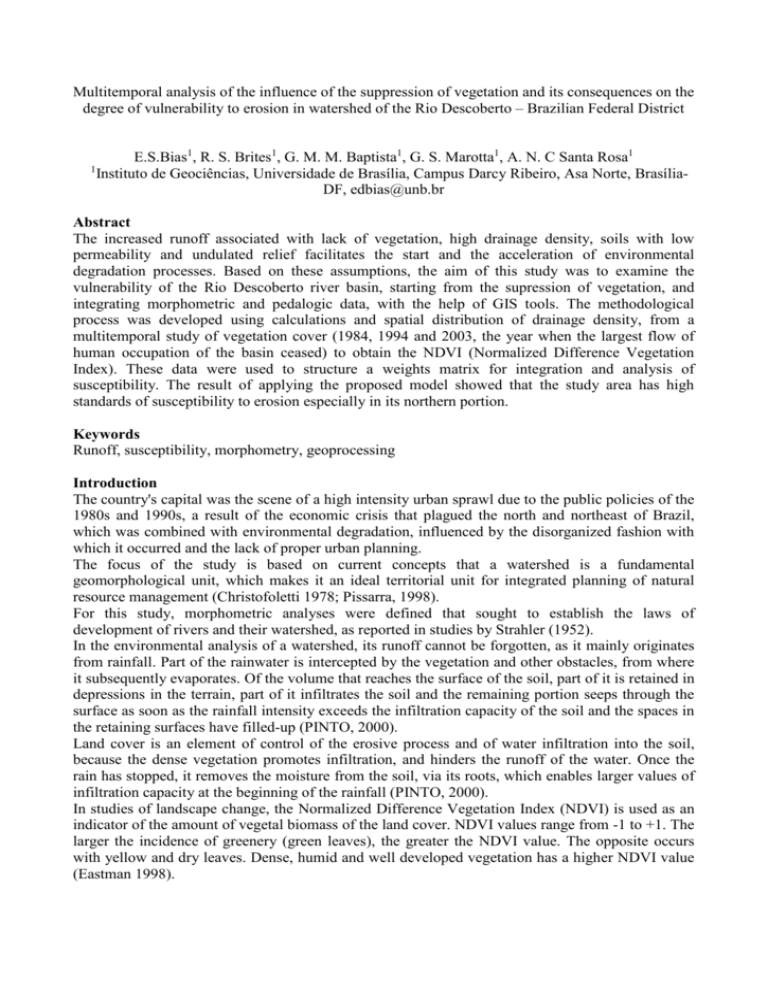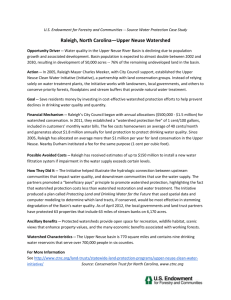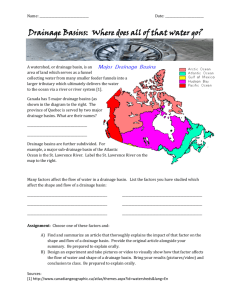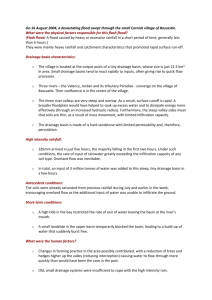Multitemporal analysis of the influence of the suppression of
advertisement

Multitemporal analysis of the influence of the suppression of vegetation and its consequences on the degree of vulnerability to erosion in watershed of the Rio Descoberto – Brazilian Federal District 1 E.S.Bias1, R. S. Brites1, G. M. M. Baptista1, G. S. Marotta1, A. N. C Santa Rosa1 Instituto de Geociências, Universidade de Brasília, Campus Darcy Ribeiro, Asa Norte, BrasíliaDF, edbias@unb.br Abstract The increased runoff associated with lack of vegetation, high drainage density, soils with low permeability and undulated relief facilitates the start and the acceleration of environmental degradation processes. Based on these assumptions, the aim of this study was to examine the vulnerability of the Rio Descoberto river basin, starting from the supression of vegetation, and integrating morphometric and pedalogic data, with the help of GIS tools. The methodological process was developed using calculations and spatial distribution of drainage density, from a multitemporal study of vegetation cover (1984, 1994 and 2003, the year when the largest flow of human occupation of the basin ceased) to obtain the NDVI (Normalized Difference Vegetation Index). These data were used to structure a weights matrix for integration and analysis of susceptibility. The result of applying the proposed model showed that the study area has high standards of susceptibility to erosion especially in its northern portion. Keywords Runoff, susceptibility, morphometry, geoprocessing Introduction The country's capital was the scene of a high intensity urban sprawl due to the public policies of the 1980s and 1990s, a result of the economic crisis that plagued the north and northeast of Brazil, which was combined with environmental degradation, influenced by the disorganized fashion with which it occurred and the lack of proper urban planning. The focus of the study is based on current concepts that a watershed is a fundamental geomorphological unit, which makes it an ideal territorial unit for integrated planning of natural resource management (Christofoletti 1978; Pissarra, 1998). For this study, morphometric analyses were defined that sought to establish the laws of development of rivers and their watershed, as reported in studies by Strahler (1952). In the environmental analysis of a watershed, its runoff cannot be forgotten, as it mainly originates from rainfall. Part of the rainwater is intercepted by the vegetation and other obstacles, from where it subsequently evaporates. Of the volume that reaches the surface of the soil, part of it is retained in depressions in the terrain, part of it infiltrates the soil and the remaining portion seeps through the surface as soon as the rainfall intensity exceeds the infiltration capacity of the soil and the spaces in the retaining surfaces have filled-up (PINTO, 2000). Land cover is an element of control of the erosive process and of water infiltration into the soil, because the dense vegetation promotes infiltration, and hinders the runoff of the water. Once the rain has stopped, it removes the moisture from the soil, via its roots, which enables larger values of infiltration capacity at the beginning of the rainfall (PINTO, 2000). In studies of landscape change, the Normalized Difference Vegetation Index (NDVI) is used as an indicator of the amount of vegetal biomass of the land cover. NDVI values range from -1 to +1. The larger the incidence of greenery (green leaves), the greater the NDVI value. The opposite occurs with yellow and dry leaves. Dense, humid and well developed vegetation has a higher NDVI value (Eastman 1998). Based on the concepts presented, the general objective of this study is to propose the evaluation of the susceptibility of soil based on GIS tools. Location and Physical Characteristics of the Watershed The study area is shown in Figure 1 and is located between 15º 35 '07'' and 15°48' 22'' latitude South and between the meridians 48° 02 '03'' and 48°16 '33'' longitude West in the western part of the Federal District, with an extension of 791.62 km ². Figure 1 – Location of the Watershed The climate is predominantly tropical (Aw) according to the Köppen Climate Classification, with rainfall ranging from 750-2000 mm / year on average, characterized by seasonal rainfall, with a dry winter lasting from 4 to 5 months and a rainy summer, with greater precipitation during the months of December, January and February. Altitude ranges between 800 and 1,500m. (BAPTISTA 1998). According to Freitas-Silva & Campos (1998), of the watershed of the Rio Descoberto is located within the Paranoá and Araxá Group geological units, which represent 64% and 36% respectively of the study area. According to CODEPLAN (1996), the watershed of the Rio Descoberto has four classes of geomorphology: 1. Interplanaltimetric depressions – Pediplane and High Maranhão Dried Plateau - 800 to 950 m; 2. Rodeador Contagem Pediplane – 1,200 to 1,400 m; 3. Brasilia Pediplane - 950 to 1,200 m; 4. Alluvial and Alveolar Plains. According to EMBRAPA (1999), Latosols and Cambisols dominate in the watershed of the Rio Descoberto and account for more than 95% of the total area. Materials LANDSAT 5 satellite images for 1984, 1994 and 2003.SRTM images (90 meter resolution). Vectorial file of the Basin Management Units (HU) at a scale of 1:100,000. Drainage network extracted from the Mapping System of the Federal District - SICAD DF, scale 1:10,000. Pedological base developed by EMBRAPA (1978), scale 1:100,000. Method Adjustment of drainage network extracted from SICAD/DF for the polygons of the Watershed Management Units of the watershed of the Rio Descoberto for subsequent ranking, based on the method of Strahler. To obtain the morphometric data (linear variables and areas of the basin), the methodology suggested by Christofoletti (1980) was applied and subsequently partitioning of the basin was carried out by drainage density range, dividing it into 4 (four) classes: low, medium, high and very high. The adjustment of topographical limits of the drainage of the watershed and the creation of the map of slope were carried out based on SRTM data, using the Spatial Analyst module of ArcGIS. LANDSAT TM images were georeferenced to the Astro Chuá Datum and they were compatible with the reference system of the Federal District’s Mapping System. The NDVIs for the 3 (three) years proposed were processed and quantified. The result of each year was divided into four classes based on the analysis of the histogram (nil, low, medium and high). The procedures presented in Figure 2 were carried out after the georeferencing of images. Figure 2 - Flow of generation of the study with the images for the NDVI generation and analysis of susceptibility Adapted from Bias (1998), the Susceptibility map was defined using a weights matrix, according to Table 1. Table 1 - Weights Matrix NDVI Division Classes Weight Nil 1 Slope Classes 0–5 Weight 1 Pedology Classes Plintisols Weight 1 Drainage Density Classes Weight Low 1 Low Medium 2 3 5 – 10 10 – 20 2 3 Cambisols Latossolos 2 3 Medium High 2 3 High 4 > 20 4 Neosols 4 Very high 4 The integration of the model was constructed according to Figure 3. Figure 3 - Flow-generation model of susceptibility to permeability Results and Discussion The result of the ranking of the watershed of the Rio Descoberto (Table 2 and Figure 5) presented a seventh order drainage, and the greatest concentration of drainage density was in the southern part of the basin. Table 2 - Results of the ranking of the drainage network Information Order of the channels Total 1ª 2ª 3ª 4ª 5ª 6ª 7ª Number of channels 8,356 1,900 443 95 19 4 1 10,818 Length(km) 1,322.49 534.16 267.81 136.56 75.47 75.47 20.31 2,447.72 Most of the basin has an latosols type, and the terrain can be characterized as flat to gently undulated. Approximately 62.80% of the area's topography has flat relief, 26.46% is flat undulated relief and the remainder (10.9%) is undulated to strongly undulated. The data show that the slope of the basin enables good permeability due to the prevalence of flat regions, which are also ideal for urban occupation and grazing and agriculture practices, a fact that directly influences the environmental fragility due to increased runoff. Based on the NDVI, it was possible to quantify multitemporally the variation of the interception of rainwater. The level of interception was defined in four categories: nil (totally urbanized area), low, medium and high. From the integration of products it was possible to obtain the results presented in Table 3 and Figure 6. Table 3 - Percentages of susceptibility per class Degree of Percentage of susceptibility susceptibility 1984 1994 Nil (urbanized area) 12.28 10.26 Low 5.58 5.25 Intermediate 49.74 48.76 High 32.40 35.74 2003 20.27 6.31 46.32 27.10 Figure 6 – Multitemporal maps of susceptibility variation for the basin Analyzing Table 3 and Figure 6, one can observe the increase in the nil classes because of the creation of new housing settlements in the basin and of low susceptibility that show little variation. The classes of intermediate and high susceptibility were reduced, particularly the class of high susceptibility in terms of occupation in the southeastern part of the basin due to the new urban settlement. The spatial distribution of vulnerability showed, however, that the highest risk areas remain in the northern part of the basin, which needs to be closely watched regarding urban occupation, given the risks that this process can bring about mainly due to the replacement of vegetation by impermeable land cover. Conclusions The proposed Susceptibility model responded in a very efficient manner, contributing to the accomplishment of a multitemporal view of the environmental fragility to erosive processes, and, it can be used as a tool for environmental planning and management of watersheds. References BAPTISTA, G.M.M. Caracterização climatológica do Distrito Federal. In: Inventário hidrogeológico e dos recursos hídricos superficiais do Distrito Federal. Brasília: Governo do Distrito Federal. 1998. CHRISTOFOLETTI, A. Os sistemas morfogenéticos in Geomorfologia. 2. ed. São Paulo: Edgard Blücher. 1980. CODEPLAN. Mapas temáticos do Distrito Federal. Brasília: Governo do Distrito Federal, 1996. EASTMAN, J. R. Idrisi for Windows. Manual do usuário. Trad. HASENACK, H.; WEBER, E. Porto Alegre: UFRGS, Centro de Recursos Idrisi, Brasil, 1998 EMBRAPA. Sistema Brasileiro de Classificação de Solos. Brasília: Empresa Brasileira de Pesquisa Agropecuária, Serviço de Produção de Informação. 1999. FREITAS-SILVA, F.H; Campos, J.E.G. Geologia do Distrito Federal. In: Inventário hidrogeológico e dos recursos hídricos superficiais do Distrito Federal. Brasília: Governo do Distrito Federal. 1998. PINTO, N. L. S. Hidrologia básica. 7. reimp. São Paulo: Edgard Blücher, 2000. 278 p. PISSARRA T. C. T.; POLITANO, W.; FERRAUDO, A. S.. Avaliação de características morfométricas na relação solo-superfície da Bacia Hidrográfica do Córrego Rico, Jaboticabal (SP). Rev. Bras. Ciênc. Solo , Viçosa , v. 28, n. 2, 2004 . Disponível em:<http://www.scielo.br/scielo.php?script=sci_arttext&pid=S0100068320040002000 08&lng=pt&nrm=iso>. Acesso em: 02 Set 2007. SCHIER, R. A. Trajetórias do conceito de paisagem na geografia. Editora UFPR, R. RA’E GA, n. 7, p. 79-85, Curitiba, 2003. STRAHLER, A. N. Hypsometric (area-altitude) analysis and erosional topography. Geological Society of America Bulletin, v. 63, p. 1117-1142, 1952.







